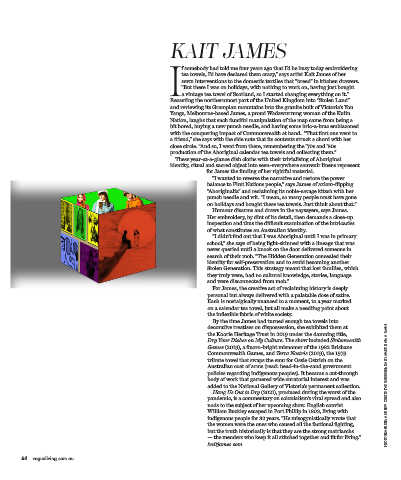Page 56 - 2022-07-01VogueLivingar
P. 56
KAIT JAMES
f somebody had told me four years ago that I’d be busy today embroidering
tea towels, I’d have declared them crazy,” says artist Kait James of her
sewn interventions to the domestic textiles that “breed” in kitchen drawers.
“But there I was on holidays, with nothing to work on, having just bought
Ia vintage tea towel of Scotland, so I started changing everything on it.”
Recasting the northernmost part of the United Kingdom into “Stolen Land”
and reviewing its Grampian mountains into the granite bulk of Victoria’s You
Yangs, Melbourne-based James, a proud Wadawurrung woman of the Kulin
Nation, laughs that such fanciful manipulation of the map came from being a
bit bored, buying a new punch needle, and having some bric-a-brac emblazoned
with the conquering impact of Commonwealth at hand. “That first one went to
a friend,” she says with the side note that its contents struck a chord with her
close circle. “And so, I went from there, remembering the ’70s and ’80s
production of the Aboriginal calendar tea towels and collecting them.”
These year-at-a-glance dish cloths with their trivialising of Aboriginal
identity, ritual and sacred object into seen-everywhere souvenir linens represent
for James the finding of her rightful material.
“I wanted to reverse the narrative and restore the power
balance to First Nations people,” says James of axiom-flipping
“Aboriginalia” and reclaiming its noble-savage kitsch with her
punch needle and wit. “I mean, so many people must have gone
on holidays and bought these tea towels. Just think about that.”
Humour disarms and draws in the naysayers, says James.
Her embroidery, by dint of its detail, then demands a close-up
inspection and thus the difficult examination of the intricacies
of what constitutes an Australian identity.
“I didn’t find out that I was Aboriginal until I was in primary
school,” she says of being light-skinned with a lineage that was
never queried until a knock on the door delivered someone in
search of their mob. “The Hidden Generation concealed their
identity for self-preservation and to avoid becoming another
Stolen Generation. This strategy meant that lost families, which
they truly were, had no cultural knowledge, stories, language
and were disconnected from mob.”
For James, the creative act of reclaiming history is deeply
personal but always delivered with a palatable dose of satire.
Each is nostalgically nuanced to a moment, to a year marked
on a calendar tea towel, but all make a needling point about
the inflexible fabric of white society.
By the time James had turned enough tea towels into
decorative treatises on dispossession, she exhibited them at
the Koorie Heritage Trust in 2019 under the damning title,
Dry Your Dishes on My Culture. The show included Stolenwealth
Games (2019), a fluoro-bright misnomer of the 1982 Brisbane
Commonwealth Games, and Terra Nostris (2019), the 1979
tribute towel that swaps the emu for Ossie Ostrich on the
Australian coat of arms (read: head-in-the-sand government
policies regarding indigenous peoples). It became a cut-through
body of work that garnered wide curatorial interest and was
added to the National Gallery of Victoria’s permanent collection. PHOTOGRAPHERS: ANDREW CURTIS (YAS QUEENIE); KAIT JAMES (I AM A MAN)
Hang Us Out to Dry (2021), produced during the worst of the
pandemic, is a commentary on colonialism’s viral spread and also
nods to the subject of her upcoming show. English convict
William Buckley escaped in Port Phillip in 1803, living with
indigenous people for 32 years. “He misogynistically wrote that
the women were the ones who caused all the factional fighting,
but the truth historically is that they are the strong matriarchs
— the menders who keep it all stitched together and fit for living.”
kaitjames.com
64 vogueliving.com.au

